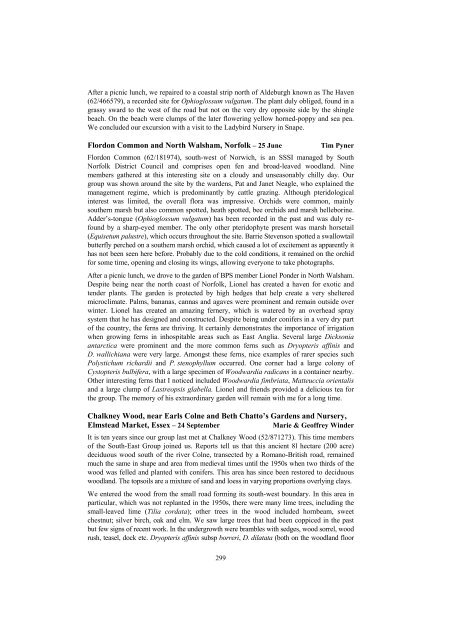REGIONAL MEETINGS - Natural History Museum
REGIONAL MEETINGS - Natural History Museum
REGIONAL MEETINGS - Natural History Museum
Create successful ePaper yourself
Turn your PDF publications into a flip-book with our unique Google optimized e-Paper software.
After a picnic lunch, we repaired to a coastal strip north of Aldeburgh known as The Haven<br />
(62/466579), a recorded site for Ophioglossum vulgatum. The plant duly obliged, found in a<br />
grassy sward to the west of the road but not on the very dry opposite side by the shingle<br />
beach. On the beach were clumps of the later flowering yellow horned-poppy and sea pea.<br />
We concluded our excursion with a visit to the Ladybird Nursery in Snape.<br />
Flordon Common and North Walsham, Norfolk – 25 June Tim Pyner<br />
Flordon Common (62/181974), south-west of Norwich, is an SSSI managed by South<br />
Norfolk District Council and comprises open fen and broad-leaved woodland. Nine<br />
members gathered at this interesting site on a cloudy and unseasonably chilly day. Our<br />
group was shown around the site by the wardens, Pat and Janet Neagle, who explained the<br />
management regime, which is predominantly by cattle grazing. Although pteridological<br />
interest was limited, the overall flora was impressive. Orchids were common, mainly<br />
southern marsh but also common spotted, heath spotted, bee orchids and marsh helleborine.<br />
Adder’s-tongue (Ophioglossum vulgatum) has been recorded in the past and was duly refound<br />
by a sharp-eyed member. The only other pteridophyte present was marsh horsetail<br />
(Equisetum palustre), which occurs throughout the site. Barrie Stevenson spotted a swallowtail<br />
butterfly perched on a southern marsh orchid, which caused a lot of excitement as apparently it<br />
has not been seen here before. Probably due to the cold conditions, it remained on the orchid<br />
for some time, opening and closing its wings, allowing everyone to take photographs.<br />
After a picnic lunch, we drove to the garden of BPS member Lionel Ponder in North Walsham.<br />
Despite being near the north coast of Norfolk, Lionel has created a haven for exotic and<br />
tender plants. The garden is protected by high hedges that help create a very sheltered<br />
microclimate. Palms, bananas, cannas and agaves were prominent and remain outside over<br />
winter. Lionel has created an amazing fernery, which is watered by an overhead spray<br />
system that he has designed and constructed. Despite being under conifers in a very dry part<br />
of the country, the ferns are thriving. It certainly demonstrates the importance of irrigation<br />
when growing ferns in inhospitable areas such as East Anglia. Several large Dicksonia<br />
antarctica were prominent and the more common ferns such as Dryopteris affinis and<br />
D. wallichiana were very large. Amongst these ferns, nice examples of rarer species such<br />
Polystichum richardii and P. stenophyllum occurred. One corner had a large colony of<br />
Cystopteris bulbifera, with a large specimen of Woodwardia radicans in a container nearby.<br />
Other interesting ferns that I noticed included Woodwardia fimbriata, Matteuccia orientalis<br />
and a large clump of Lastreopsis glabella. Lionel and friends provided a delicious tea for<br />
the group. The memory of his extraordinary garden will remain with me for a long time.<br />
Chalkney Wood, near Earls Colne and Beth Chatto’s Gardens and Nursery,<br />
Elmstead Market, Essex – 24 September Marie & Geoffrey Winder<br />
It is ten years since our group last met at Chalkney Wood (52/871273). This time members<br />
of the South-East Group joined us. Reports tell us that this ancient 8l hectare (200 acre)<br />
deciduous wood south of the river Colne, transected by a Romano-British road, remained<br />
much the same in shape and area from medieval times until the 1950s when two thirds of the<br />
wood was felled and planted with conifers. This area has since been restored to deciduous<br />
woodland. The topsoils are a mixture of sand and loess in varying proportions overlying clays.<br />
We entered the wood from the small road forming its south-west boundary. In this area in<br />
particular, which was not replanted in the 1950s, there were many lime trees, including the<br />
small-leaved lime (Tilia cordata); other trees in the wood included hornbeam, sweet<br />
chestnut; silver birch, oak and elm. We saw large trees that had been coppiced in the past<br />
but few signs of recent work. In the undergrowth were brambles with sedges, wood sorrel, wood<br />
rush, teasel, dock etc. Dryopteris affinis subsp borreri, D. dilatata (both on the woodland floor<br />
299
















